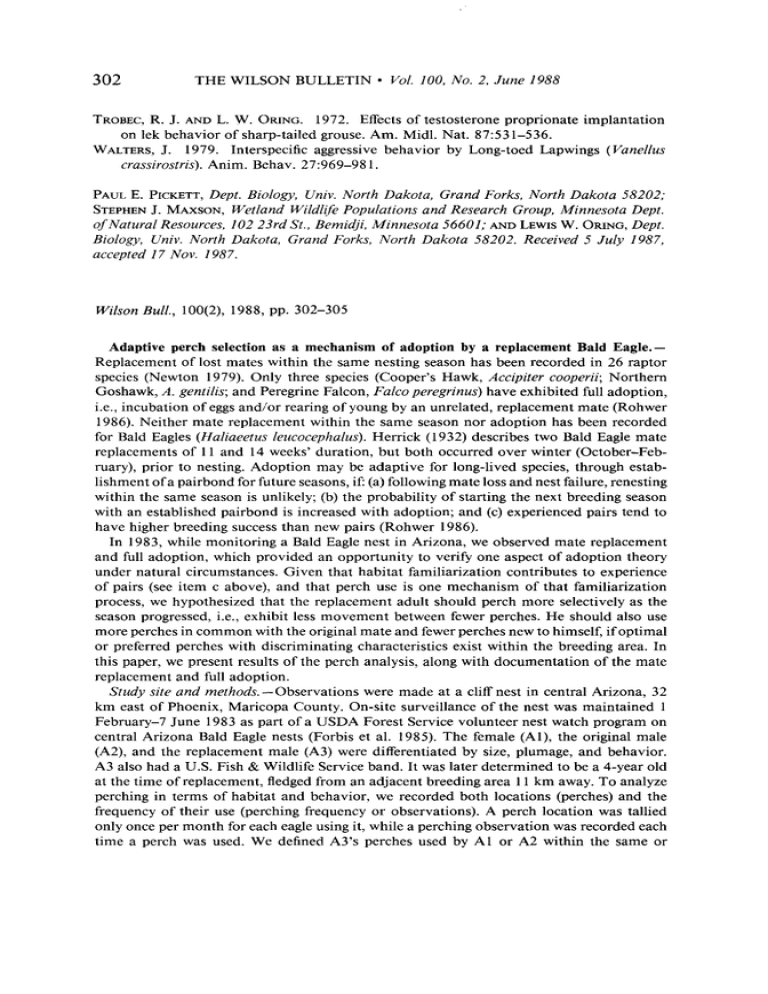302 Vol. 100, No.
advertisement

302 THE WILSON BULLETIN l Vol. 100, No. 2, June 1988 TROBEC, R. J. AND L. W. ORING. 1972. Effects of testosterone proprionate implantation on lek behavior of sharp-tailed grouse. Am. Midl. Nat. 87:531-536. WALTERS, J. 1979. Interspecific aggressive behavior by Long-toed Lapwings (Vanellus crassirostris).Anim. Behav. 27~969-98 1. PAUL E. PICKETT, Dept. Biology Univ. North Dakota, Grand Forks, North Dakota 58202; STEPHENJ. MAXSON, Wetland Wildlife Populationsand ResearchGroup, Minnesota Dept. of Natural Resources,102 23rd St., Bemidji, Minnesota 56601; AND LEWIS W. ORING, Dept. Biology, Univ. North Dakota, Grand Forks, North Dakota 58202. Received5 July 1987, accepted17 Nov. 1987. Wilson Bull., 100(2), 1988, pp. 302-305 Adaptive perch selection as a mechanism of adoption by a replacement Bald Eagle.Replacement of lost mates within the same nesting season has been recorded in 26 raptor species (Newton 1979). Only three species (Cooper’s Hawk, Accipiter cooper& Northern Goshawk, A. gentilis;and Peregrine Falcon, Falco peregrinus)have exhibited full adoption, i.e., incubation of eggs and/or rearing of young by an unrelated, replacement mate (Rohwer 1986). Neither mate replacement within the same season nor adoption has been recorded for Bald Eagles (Haliaeetus leucocephalus). Herrick (1932) describes two Bald Eagle mate replacements of 11 and 14 weeks’ duration, but both occurred over winter (October-February), prior to nesting. Adoption may be adaptive for long-lived species, through establishment of a pairbond for future seasons, if: (a) following mate loss and nest failure, renesting within the same season is unlikely; (b) the probability of starting the next breeding season with an established pairbond is increased with adoption; and (c) experienced pairs tend to have higher breeding success than new pairs (Rohwer 1986). In 1983, while monitoring a Bald Eagle nest in Arizona, we observed mate replacement and full adoption, which provided an opportunity to verify one aspect of adoption theory under natural circumstances. Given that habitat familiarization contributes to experience of pairs (see item c above), and that perch use is one mechanism of that familiarization process, we hypothesized that the replacement adult should perch more selectively as the season progressed, i.e., exhibit less movement between fewer perches. He should also use more perches in common with the original mate and fewer perches new to himself, if optimal or preferred perches with discriminating characteristics exist within the breeding area. In this paper, we present results of the perch analysis, along with documentation of the mate replacement and full adoption. Study site and methods.-Observations were made at a cliff nest in central Arizona, 32 km east of Phoenix, Maricopa County. On-site surveillance of the nest was maintained 1 February-7 June 1983 as part of a USDA Forest Service volunteer nest watch program on central Arizona Bald Eagle nests (Forbis et al. 1985). The female (Al), the original male (A2), and the replacement male (A3) were differentiated by size, plumage, and behavior. A3 also had a U.S. Fish & Wildlife Service band. It was later determined to be a 4-year old at the time of replacement, fledged from an adjacent breeding area 11 km away. To analyze perching in terms of habitat and behavior, we recorded both locations (perches) and the frequency of their use (perching frequency or observations). A perch location was tallied only once per month for each eagle using it, while a perching observation was recorded each time a perch was used. We defined A3’s perches used by Al or A2 within the same or SHORT 303 COMMUNICATIONS 160 140 (23 Original m Replacement Male Male 120 100 80 60 40 20 0 Feb Mar m May Perching frequency during adoption for original and replacement males and the resident female at a Bald Eagle nest in central Arizona, 1983. FIG. 1. previous months as common. Perches not used by A3 during previous months were called new. Results and discussion.-Incubation began about 25 January 1983. On 13 February, after incubation and a typical nest exchange, A2 disappeared. Over the next 7 days, Al did not feed and was off the nest a total of only 25 min. A3 flew into the area on 14 February. He appeared restless when perching and made many short flights, changing perches often to new and different locations. A3 also frequently perched, roosted, and arranged nest material on a nearby, alternate nest. At first Al watched A3 alertly, vocalized often, and chased him off when he came close. Display flights (A3 flying by Al with a stick, a fish, or with legs and feet extended) began on 16 February and increased in frequency through 20 February. On 17 February, A3 landed uncontested on the nest ledge. A brief courtship flight followed, wherein the two eagles presented talons and cartwheeled. The frequency and duration of courtship flights increased through the end of the month, with brief perching together away from the nest and Al initiating courtship activity by 2 1 February. A3’s first stick delivery and first prey delivery occurred on 19 February. Soon thereafter, both birds commonly fed and arranged nest material together. Copulatory behavior first occurred on 24 February. On 27 February, A3 began incubating or brooding (exact hatching date uncertain). We observed three nest exchanges that day and six on 28 February, which marked the onset of 304 THE WILSON BULLETIN . Vol. 100, No. 2, June 1988 normal nest attendance, indistinguishable from that of other established breeding pairs in Arizona. Three eaglets fledged about 16 May, after a typical 77-day nestling period (1983 population mean 79 days, Grubb and Forbis, unpubl. data). A3 fully participated in provisioning, feeding, and attending the young during this time. This quick and successful mate replacement is indicative of a healthy population with a pool of nonbreeding adult eagles (Newton 1979). Bald Eagles in Arizona meet all three conditions set forth by Rohwer (1986) for adoption to be adaptive (Grubb and Forbis, unpubl.). Thus, A3, who as a 4-year old was likely seeking his first mate and nest site, could certainly afford to adopt and rear A2’s offspring in order to: (a) secure a viable breeding area, (b) obtain a proven mate for future nesting seasons, and (c) improve the likelihood of his own productivity the following year. The dramatic difference in A3’s perching frequency over A2’s and the use of different perches by A3 were the first signs that replacement was occurring (Fig. 1). The progressive decline for A3 during the period indicates decreasing movement between perches. The pattern of total monthly perches for all three adults was similar, with A3 dropping from 64 perches in February to 20 in May. Only 12 (19%) of A3’s February perches were common to the other eagles, whereas in May, 10 of 20 perches (50%) were common perches. Conversely, the percent of new perches per month for A3 declined from 100% in February to 35% (11 of 31) by April. We recorded approximately three times the perching observations (409 vs 141) at 1.6 times the perches (123 vs 78) for A3 as for Al (P i 0.05, adjusted G-statistic, 3 df, Sokal and Rohlf 198 1). Some of this difference may be due to sexual differences in behavior during nesting. However, we include Al’s data for comparison because: (a) during February, Al and A2 showed similar perching patterns (47 observations at 40 perches and 39 at 32, respectively), (b) the frequency of perches and perching observations for Al was relatively stable throughout the period, and (c) both perching measures for A3 progressively converged on Al’s figures until near parity by May (A3-40 observations at 20 perches; Al -34 at 18) (Fig. 1). Results of our perching analysis for A3 evidence adaptive perch selection, which, as a mechanism of habitat familiarization and ultimately A3’s experience, should have improved his fitness for subsequent breeding seasons. No further perching data are available, but the A 1-A3 pair successfully fledged 2 young in 1984 and have continued to produce 2-3 young per year since. Acknowledgments. -We thank R. Orr and J. Kaiser, Mesa Ranger District, Tonto National Forest, for special field and administrative support that made these observations possible. K. Berger also assisted with field work. R. Bowman, W. Eakle, J. Hodges, and S. Rohwer provided helpful reviews of an earlier draft. USDA Forest Service, U.S. Fish and Wildlife Service, and Bureau of Reclamation funded this study through interagency agreement. LITERATURE CITED FORBIS, L. A., T. G. GRUBB, AND W. E. ZEEDYK. 1985. A volunteer bald eagle nest watch program on Arizona National Forests. Pp. 246-254 in Proceedings of Bald Eagle Days, 1983 (J. M. Gerrard and T. N. Ingram, eds.). The Eagle Foundation, Apple River, Illinois. HERRICK, F. H. 1932. Daily life of the American eagle: early phase. Auk 49:307-323. NEWTON, I. 1979. Population ecology of raptors. Buteo Books, Vermillion, South Dakota. ROHWER, S. 1986. Selection for adoption versus infanticide by replacement “mates” in birds. Pp. 353-395 in Current ornithology (R. F. Johnston, ed.). Plenum Press, New York, New York. SOKAL, R. R. AND F. J. ROHLF. 198 1. Biometry, 2nd ed. Freeman, San Francisco, California. SHORT COMMUNICATIONS 305 TERYL G. GRUBB,USDA Forest Service,Rocky Mountain Forest and Range Experiment USDA ForestService, Station,ASlJCampus, Tempe,Arizona 85287-1304; LARRY A. FORBIS, Tonto National Forest, P.O. Box 5348, Phoenix, Arizona 85050; MARTAMCWHORTER,16 Portola Green Circle, Portola Valley, California 94025; AND DAVID R. SHERMAN,803 N. Main St., Ashland, Oregon97520. Received21 May 1987, accepted4 Dec. 1987. Wilson Bull., 100(2), 1988, pp. 305-306 Use of Red-winged Blackbird nest by a Prothonotary Warbler.-Apart from the use of old woodpecker holes, reports of cavity-nesting birds using nests (particularly open-cup nests) built by other species are rare. Interspecific nest use has more commonly been reported in open-nesting species (e.g., Finch, Wilson Bull. 94582-584, 1982). We document here the first case of a Prothonotary Warbler (Protonotariacitrea), a cavity-nesting wood-warbler of swampy or riparian habitat, using an open-cup nest built by another bird species. Prothonotary Warblers have been known to nest rarely in some unusual man-made nest sites (Bent, U.S. Natl. Mus. Bull. 203, 1953) all of which resembled natural cavities to some extent. The nesting we report here occurred when all suitable natural cavities and nest boxes in the vicinity were unavailable due to an extremely high local density of Prothonotary Warblers. The study site is located along the Tennessee River in Benton County, Tennessee. As part of a larger study on the reproductive ecology of Prothonotary Warblers (Petit, L., M.S. thesis, Bowling Green State Univ., Bowling Green, Ohio, 1986), nest boxes were erected in linear fashion along the river shoreline in densities of 0, 8, and 20 nest boxes per 300 m. On 1 June 1987, an unbanded male Prothonotary Warbler was observed on one ofthe high density nest box plots defending a small (0.08 ha) territory which did not encompass any of the 20 boxes present. Territorial boundaries were determined from >2 h of observation on that day. Vegetation on the territory consisted of a small knob of willows (Salix spp.) and buttonbush (Cephalanthusoccidentalis)that extended into the river from the main contour of the shoreline. The male was apparently unmated, as no female was observed in his territory in 1 h of intensive observation. Probst and Hayes (Auk 104:234-24 1, 1987) found that l1.5 h of observation was sufficient to determine pairing success of Kirtland’s Warblers (Dendroicakirtlandii). Six mated males also occupied territories on the plot, five of them within a 150 m length of shoreline adjacent to the male’s territory. This represents a density of Prothonotary Warblers six times greater than that occurring naturally in this habitat (Petit 1986). Collectively, those 6 males defended all 20 nest boxes and two natural cavities on the plot, rendering them unavailable to the unmated male. There was one woodpecker cavity located within the unmated male’s territory, but it was occupied by Tree Swallows (Tachy- cineta bicolor). The male was observed on several days during the following week, and on 9 June, an unbanded female Prothonotary Warbler was seen foraging within his territory. The female entered a Red-winged Blackbird (Agelaiusphoeniceus)nest that was situated approximately 1 m above water in the crotch of a branch of a 2-m-tall buttonbush. The female remained on the nest for approximately 5 min before leaving to forage again. The nest contained 2 Prothonotary Warbler eggs, and it was lined with a thin layer of moss along the inner walls of the nest cup. During 1 h of observation (12:00-l 3:00), the female incubated three times








